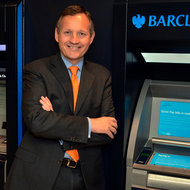 Brendan Smialowski/Agence France-Presse — Getty ImagesLloyd Blankfein, chief of Goldman Sachs, at the White House in February.
Brendan Smialowski/Agence France-Presse — Getty ImagesLloyd Blankfein, chief of Goldman Sachs, at the White House in February.
Goldman Sachs posted second-quarter profit on Tuesday that was twice what it reported in the period a year earlier, fueled by strong trading and investment banking results.
Net income was $1.93 billion, or $3.70 a share, compared with $962 million, or $1.78 a share, in the period a year earlier. It was also well ahead of analysts’ expectations of $2.82 a share, according to Thomson Reuters.
Related Links
Revenue in the quarter rose to $8.6 billion from $6.6 billion in the year-ago period.
“The firm’s performance was solid, especially in the context of mixed economic sentiment during the quarter,” Goldman’s chairman and chief executive, Lloyd C. Blankfein, said in a statement.
Goldman clearly benefited from an improving economy in the second quarter. The period was dominated by a sudden and sharp rise in interest rates after the Federal Reserve indicated it might wind down its big bond purchase program, which has helped the economy recover from the financial crisis. Unlike JPMorgan Chase, Goldman is not a big player in originating residential mortgages, but it does trade mortgage products; the rise in rates can both help and hurt firms like Goldman, depending on the businesses they are in.
The rates move was felt most in Goldman’s fixed-income, or bond, department. Net revenue in the unit was $2.46 billion, up 12 percent from the period a year earlier, reflecting what the company said was significantly higher net revenue in currencies, credit products and commodities. Still, these increases were offset in part by significantly lower revenue in mortgages and interest-rate products, the company said.
The bank reduced the risk it was taking in products related to interest rates. The firm’s so-called value-at-risk in rates declined to an average of $59 million in the second quarter from $83 million in the period a year earlier and $62 million in the first quarter. Value-at-risk is a yardstick of the amount of losses that could be experienced in one trading day.
The firm’s annualized return on equity was 10.5 percent, down from 11.5 percent in the period a year earlier. It was far below its performance in boom years like of 2006, when its return on equity was 41.5 percent.
Revenue from investing and lending activities came in at $1.42 billion for the second quarter, up from just $203 million in the period a year earlier. The firm had a rather rocky second quarter in 2012, and its results in that quarter included a big loss on a significant investment in this unit.
Investment banking revenue rose 29 percent, to $1.6 billion, helped by significantly higher net revenue in debt and equity underwriting. Equity underwriting was a particular standout, jumping 51 percent, to $371 million. Debt underwriting rose 45 percent, to $695 million.
Goldman also disclosed that it set aside $3.7 billion in the quarter for compensation, up 27 percent from the period a year earlier. The current accrual represents 43 percent of revenue, which is in line with other years. Banks like Goldman set aside compensation during the year but do not pay it out until they determine earnings for the full year.
Over the last year, Goldman has reduced its payroll to 31,700 employees, down 2 percent from the period a year earlier, as the firm continues to focus on cutting costs.
Article source: http://dealbook.nytimes.com/2013/07/16/quarterly-profit-doubles-at-goldman-sachs/?partner=rss&emc=rss











